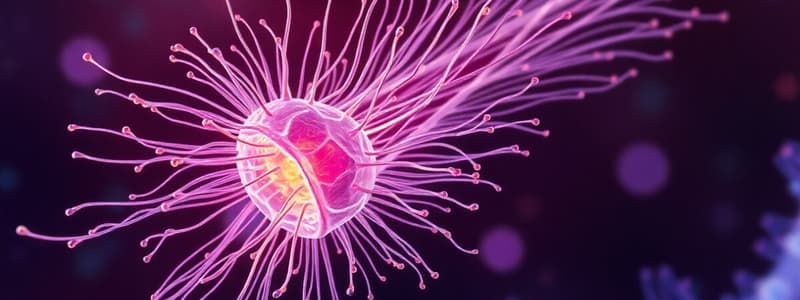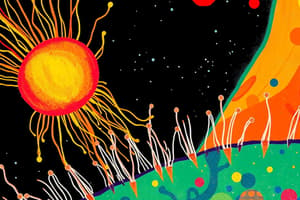Podcast
Questions and Answers
What is the primary function of flagella?
What is the primary function of flagella?
- Facilitate cell division
- Propel cells through liquid (correct)
- Move material across the surface of cells
- Transport nutrients within cells
Cilia are primarily responsible for propulsion of cells through liquid.
Cilia are primarily responsible for propulsion of cells through liquid.
False (B)
What are the three distinct classes of microtubules found in mitotic spindles?
What are the three distinct classes of microtubules found in mitotic spindles?
Kinetochore microtubules, astral microtubules, and interpolar microtubules.
During mitosis, the ______ envelope breaks down to allow chromosome alignment.
During mitosis, the ______ envelope breaks down to allow chromosome alignment.
Match the following structures with their roles in cell movement and division:
Match the following structures with their roles in cell movement and division:
What enhances microtubule dynamics during mitosis?
What enhances microtubule dynamics during mitosis?
Non-motile primary cilia are common in interphase cells.
Non-motile primary cilia are common in interphase cells.
What is the role of basal bodies in the structure of cilia and flagella?
What is the role of basal bodies in the structure of cilia and flagella?
What role do spindle checkpoint proteins play in cell division?
What role do spindle checkpoint proteins play in cell division?
Cytokinesis is primarily driven by microtubule contraction.
Cytokinesis is primarily driven by microtubule contraction.
Name one condition associated with mutations in spindle checkpoint proteins.
Name one condition associated with mutations in spindle checkpoint proteins.
The kinetochore must maintain attachment to the ______ while allowing for microtubule growth and shrinkage.
The kinetochore must maintain attachment to the ______ while allowing for microtubule growth and shrinkage.
Match the following spindle checkpoint proteins with their effects on cancer:
Match the following spindle checkpoint proteins with their effects on cancer:
What is a key requirement for chromatid separation during cell division?
What is a key requirement for chromatid separation during cell division?
What drives the process of anaphase B during cell division?
What drives the process of anaphase B during cell division?
Cytoplasmic organelles segregate randomly during cell division.
Cytoplasmic organelles segregate randomly during cell division.
Flashcards
Cilia function
Cilia function
Cilia move materials across the surface of cells.
Flagella function
Flagella function
Flagella propel cells through liquid.
Microtubule structure
Microtubule structure
Microtubules are long, hollow tubes that serve as a structural framework in cells and are involved in cell movement.
Mitosis
Mitosis
Signup and view all the flashcards
Centrosome function
Centrosome function
Signup and view all the flashcards
Kinetochore microtubules
Kinetochore microtubules
Signup and view all the flashcards
Intraflagellar transport
Intraflagellar transport
Signup and view all the flashcards
Microtubule organizing center function
Microtubule organizing center function
Signup and view all the flashcards
Kinetochore Tension
Kinetochore Tension
Signup and view all the flashcards
Spindle Checkpoint Proteins
Spindle Checkpoint Proteins
Signup and view all the flashcards
Mad2 Protein
Mad2 Protein
Signup and view all the flashcards
BubR1 Protein
BubR1 Protein
Signup and view all the flashcards
Microtubule Motors
Microtubule Motors
Signup and view all the flashcards
Anaphase B
Anaphase B
Signup and view all the flashcards
Cytokinesis
Cytokinesis
Signup and view all the flashcards
Organelle Inheritance
Organelle Inheritance
Signup and view all the flashcards
Study Notes
Cell Shape and Movement: Cilia, Flagella & Mitosis
- Microtubule Structure and Function is the focus.
- Cilia are hair-like structures that move materials across cell surfaces.
- Flagella are tail-like structures that propel cells through liquid.
- Sperm and Chlamydomonas are examples of cells with flagella.
- Ciliated epithelium is tissue with cilia.
- Microtubules are protein structures found in cilia and flagella.
- The image shows a cross-section of a cilium.
- Shows the arrangement of the microtubules (doublets and triplets).
- Diagrams depict the 9+2 arrangement of microtubules in cilia and flagella.
- Images show the structure of a cilia and flagella.
- Basal bodies are structures at the base of cilia and flagella.
- Dynein arms are proteins that create movements in cilia and flagella.
- Radial spokes are structures that connect the central microtubule to the outer doublet microtubules.
- Nexin is a protein connecting outer doublet microtubules.
- Microtubule structure shows the $\alpha$ and $\beta$ tubulin molecules.
- Trypsinized axoneme is an image of microtubule movement.
- Cells move using a power stroke and recovery stroke (sequential bending).
Mitosis
- Mitosis is cell division.
- Cytokinesis is the division of the cytoplasm.
- Mitosis in tissue-cultured lung cells is recorded with a microscope (Pol-scope)
- Different stages of mitosis are shown in the images, including interphase, prophase, prometaphase, metaphase, anaphase, and telophase.
- The diagrams show the progression of the cell cycle.
- Checkpoints in the cell cycle ensure DNA replication and environment favorability.
- Spindle checkpoints are involved in regulation of the cell's success in division.
Cyclin Dependent Kinase (CDK)
- Cyclin-dependent kinases (CDKs) control cell cycle progression.
- The video shows different checkpoints (G1, S, G2, M checkpoint).
- Regulation of whether the cell enters G1 or continues to S phase depends on the type of signals given by the environment.
- Various cyclins and CDKs regulate the cell cycle.
Centrosome Duplication
- Centrosomes are microtubule-organizing centers.
- Regulation of the cell cycle through centrosome duplication is shown.
- Centrioles are duplicated during interphase.
- Different stages of centrosome duplication/separation are represented by the images.
- The cell cycle ensures the duplication of centrosomes.
Organelle Inheritance
- Organelles are distributed during cell division.
- Cytoskeletal filaments distribute organelles between daughter cells.
- Specific types of organelles need to be segregated in distinct ways to ensure that daughter cells obtain the correct number and type of organelle.
- Mitochondrial inheritance is addressed.
- Bundled actin filament inheritance is addressed.
Chromosome Movement and Spindle Pole Separation
- Chromosome movement is addressed during anaphase.
- Spindle pole separation during anaphase is shown in figures including pulling and pushing forces.
- Microtubule motors drive chromosome movement and spindle elongation.
Microtubule Organising Centres
- Microtubule organizing centres (MTOCs) such as centrosomes organize microtubules.
- Duplication of centrosomes and their movement are essential in proper cell division.
- Microtubules elongate and shorten to contribute to movement of chromatids.
Studying That Suits You
Use AI to generate personalized quizzes and flashcards to suit your learning preferences.




